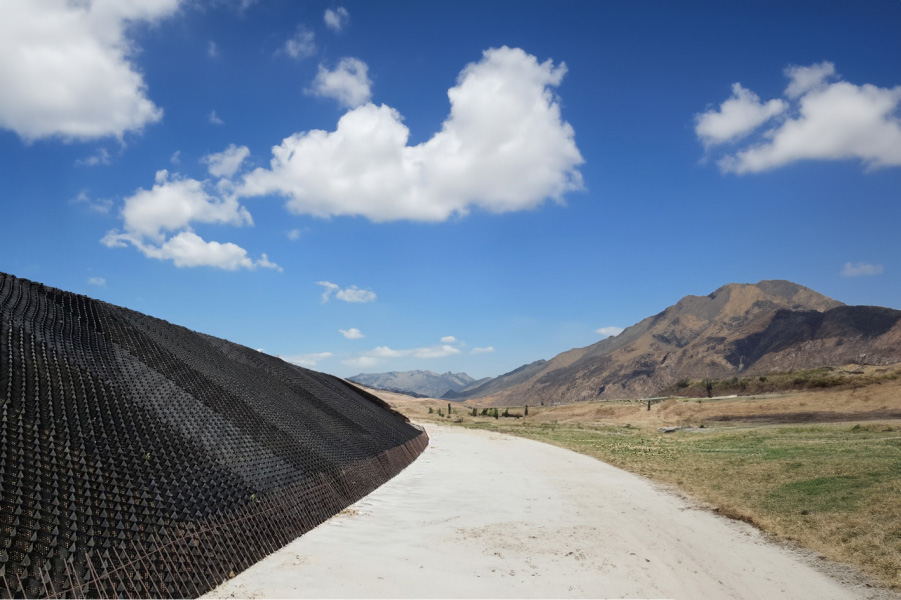Controlling erosion is a critical component of any construction site. Stable ground is the foundation of the completed construction project, necessary for the safety of your crew, and often legally required.
Below, we will detail some of the most common methods to reduce erosion. The following information is meant as a guide to choosing and installing the erosion control method that best suits your needs. When making a final decision, please ensure that you abide by all local laws and regulations.
Erosion Control Techniques
Budgets, regulations, site specifications, and more will factor into choosing the best erosion control method for your project. Regardless, the end goals are the same – to prevent soil loss and protect surrounding areas from encroaching sediment.
BaseCore GeoCells
BaseCore GeoCells form a high-density polyethylene grid that stabilizes the ground and prevents erosion. The honeycomb structure is installed on the surface and can be in-filled with a variety of low-cost aggregates. Perforations on the sides of the grid also allow for roots to cross between cells, creating an interlocking mesh system.
Soil Nails
Soil nails are often used to secure natural or artificial slopes. They work by driving long steel rods into the face of the slope, often 3 – 6 feet deep. These nails are then grouted into place, and a drainage system is constructed on the surface. Facing is then installed along the exposed ground, reducing erosion between nails.
Retaining Walls
Retaining walls can help prevent erosion between two surfaces of varying heights. While being aesthetically pleasing, they can become quite expensive, especially if they require continual upkeep. Retaining walls also require a stable foundation for construction, a problem that can be solved by first installing BaseCore GeoCells and then building on top.
French Drains
French drains primarily address erosion issues related to water flow. Keeping standing water away from the foundation of a building is critical for its longevity. French drains work by digging a trench in the waterlogged area, filling it with gravel, and laying a perforated pipe within. The pipe carries water away from the area.
Turbidity Barriers
Turbidity barriers are a form of sediment control. They are most commonly used on construction projects alongside water bodies such as streams, lakes, or oceans. The barriers consist of a flotation device, a mesh netting, and a bottom chain. They help contain any silt disturbed by construction activity.
Silt Fencing
Silt fences are above-ground fences designed to contain loose sediment within the confines of a construction site. They’re often made of porous fabric strung between wooden or metal stakes. While cheap, silt fencing is often poorly installed, making it ineffective. It also does not work well in large areas, as it concentrates water flow to the lowest point.
Articulated Concrete Blocks
Articulated concrete blocks are a permanent erosion control system similar to rip rap. The heavy blocks are connected by cables that run through pre-formed holes. The blocks are then laid across the surface like a net and can withstand powerful erosion forces. This method is most common along shorelines.
Benefits of Controlling Erosion with BaseCore Geocells
Choosing an erosion control method requires weighing cost against effectiveness. For many construction projects, BaseCore GeoCells strike the perfect balance.
Reduced Cost
One of the key benefits of BaseCore Geocells is the reduced cost compared to other methods. GeoCells can be in-filled with on-site materials, saving you from purchasing expensive aggregate and reducing hauling costs.
Because GeoCells don’t require long-term anchoring materials, they can easily be removed and reused at other job sites. Once you’re done with your current project, simply pull up the grid and transport it to your next location.
Durable
BaseCore GeoCells are made of extremely durable high-density polyethylene similar in strength to concrete. This strong base material is combined with a honeycomb pattern and perforations that allow roots to cross between cells. The result is a powerful erosion control method strong enough to withstand wind erosion, water flow, corrosion, and heavy loads.
GeoCells have been trusted by the United States Army Corps for the construction of temporary roads that needed to support tanks and other heavy equipment. In a commercial setting, you can expect the material to last over 75 years.
Eco-Friendly
BaseCore GeoCells effectively prevent silt from entering groundwater channels. The perforated grid structure retains material and slows down fast-moving water that would otherwise carry soil from erosion.
Combine your GeoCells with geotextile membranes to further prevent sediment from entering subterranean groundwater sources. By laying ground cover under the grid, you create a filtering system that traps large particles but allows water to flow down.
BaseCore Geocells Installation on Construction Sites
Another major benefit of using BaseCore GeoCells is the ease of installation. You do not need a specialist on your team, and we have ready-to-use guides and spec sheets available on our website. In as little as a few hours, you can become an expert.
There are only 5 key steps to the proper installation of BaseCore Geocell:
- Clear and excavate the space
- Lay any additional fabrics
- Install the GeoCell panels
- Secure the panels with stakes
- Add your infill materials
If you have questions about BaseCore Geocells, what to know whether or not it’s right for your erosion control needs, or need help with installation, call us today at (888) 511-1553. You can also schedule an engineering evaluation with our expert team here.
